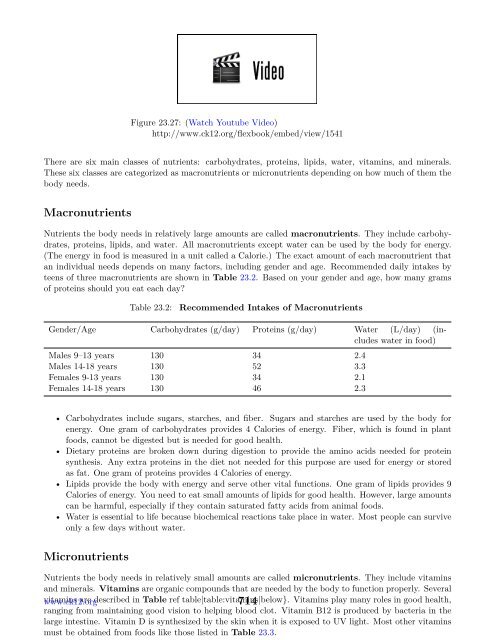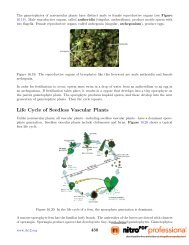Chapter 23 The Circulatory, Respiratory, Digestive, and Excretory ...
Chapter 23 The Circulatory, Respiratory, Digestive, and Excretory ...
Chapter 23 The Circulatory, Respiratory, Digestive, and Excretory ...
Create successful ePaper yourself
Turn your PDF publications into a flip-book with our unique Google optimized e-Paper software.
Figure <strong>23</strong>.27: (Watch Youtube Video)<br />
http://www.ck12.org/flexbook/embed/view/1541<br />
<strong>The</strong>re are six main classes of nutrients: carbohydrates, proteins, lipids, water, vitamins, <strong>and</strong> minerals.<br />
<strong>The</strong>se six classes are categorized as macronutrients or micronutrients depending on how much of them the<br />
body needs.<br />
Macronutrients<br />
Nutrients the body needs in relatively large amounts are called macronutrients. <strong>The</strong>y include carbohydrates,<br />
proteins, lipids, <strong>and</strong> water. All macronutrients except water can be used by the body for energy.<br />
(<strong>The</strong> energy in food is measured in a unit called a Calorie.) <strong>The</strong> exact amount of each macronutrient that<br />
an individual needs depends on many factors, including gender <strong>and</strong> age. Recommended daily intakes by<br />
teens of three macronutrients are shown in Table <strong>23</strong>.2. Based on your gender <strong>and</strong> age, how many grams<br />
of proteins should you eat each day?<br />
Table <strong>23</strong>.2: Recommended Intakes of Macronutrients<br />
Gender/Age Carbohydrates (g/day) Proteins (g/day) Water (L/day) (includes<br />
water in food)<br />
Males 9–13 years 130 34 2.4<br />
Males 14-18 years 130 52 3.3<br />
Females 9-13 years 130 34 2.1<br />
Females 14-18 years 130 46 2.3<br />
• Carbohydrates include sugars, starches, <strong>and</strong> fiber. Sugars <strong>and</strong> starches are used by the body for<br />
energy. One gram of carbohydrates provides 4 Calories of energy. Fiber, which is found in plant<br />
foods, cannot be digested but is needed for good health.<br />
• Dietary proteins are broken down during digestion to provide the amino acids needed for protein<br />
synthesis. Any extra proteins in the diet not needed for this purpose are used for energy or stored<br />
as fat. One gram of proteins provides 4 Calories of energy.<br />
• Lipids provide the body with energy <strong>and</strong> serve other vital functions. One gram of lipids provides 9<br />
Calories of energy. You need to eat small amounts of lipids for good health. However, large amounts<br />
can be harmful, especially if they contain saturated fatty acids from animal foods.<br />
• Water is essential to life because biochemical reactions take place in water. Most people can survive<br />
only a few days without water.<br />
Micronutrients<br />
Nutrients the body needs in relatively small amounts are called micronutrients. <strong>The</strong>y include vitamins<br />
<strong>and</strong> minerals. Vitamins are organic compounds that are needed by the body to function properly. Several<br />
vitamins are described in Table ref table|table:vitamins|below}. Vitamins play many roles in good health,<br />
www.ck12.org 714<br />
ranging from maintaining good vision to helping blood clot. Vitamin B12 is produced by bacteria in the<br />
large intestine. Vitamin D is synthesized by the skin when it is exposed to UV light. Most other vitamins<br />
must be obtained from foods like those listed in Table <strong>23</strong>.3.





